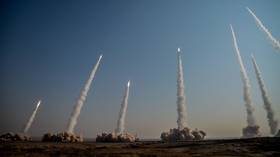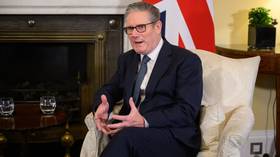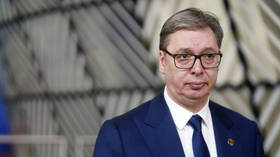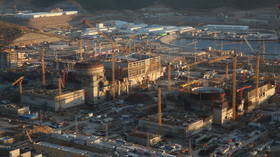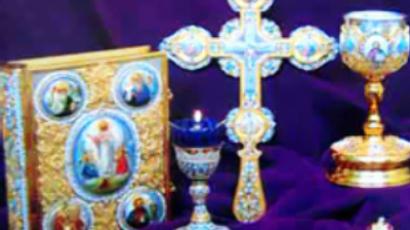Russian Orthodox Church re-unites
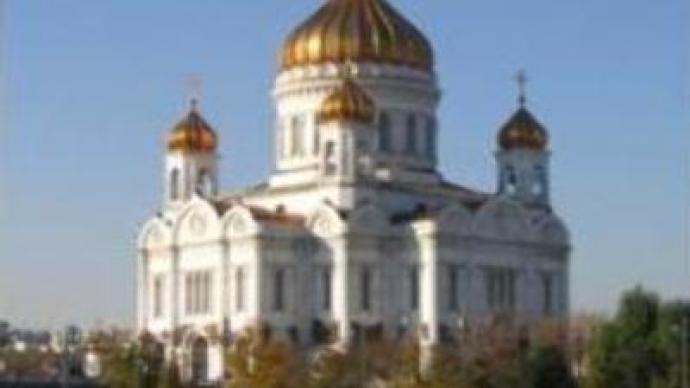
A re-unification agreement between the two branches of the Russian Orthodox Church has been signed in an elaborate ceremony at Moscow's Cathedral of Christ the Saviour.
The two branches’ heads, Patriarch Aleksy II and Metropolitan Laurus, have signed the Act of Canonical Communion declaring the formal merger of the two churches into one.The signing followed a formal announcement of approval by the Holy Synod of Russian Orthodox Church of Moscow Patriarchy and the Council of Bishops of Russian Orthodox Church Outside of Russia.The act was signed after a brief joint prayer.After that Patriarch Aleksy II, Metropolitan Laurus and Russian President Vladimir Putin delivered short speeches, outlining the historic significance of this act, mending a schism of almost a century, as well as the importance of Orthodox Christianity for all Russians, both in their motherland and abroad.Patriarch Aleksy II addressed the people: “Dear brothers and sisters, joyous are our hearts. A historical event has taken place here, which we’ve been waiting for many long years. The unity of the Russian Orthodox Church is restored. This is precious for the Church uniting its flock together and precious for our people”. Metropolitan Laurus supported Patriarch Aleksy’s words: “On this blessed day and hour of our spiritual contact I wish that the brotherly ties of both Russian Orthodox Churches influenced positively our spiritual unity and servitude to the Russian people”.The presence of the country's leader at the ceremony was no surprise, since he played a key role in the negotiations between the two churches.“The church division was the result of a profound political split in Russian society, of fierce confrontation between the sides, first of all in the civil environment,” President Vladimir Putin stressed. “And now after decades of this division we can say that in this religious and political conflict there were no winners, but everyone lost in it, both the Church and the believers themselves”.A joint divine liturgy to celebrate the event followed. It was a spectacular and elaborate ceremony, held in strict accordance with the Orthodox tradition. Since the event coincides with Easter celebrations, namely the Holy Day of Accession of Christ, the Holy Door was kept opened, allowing the parish to see all the details.After the service Patriarch Aleksy II congratulated believers on the reunification in a special televised address.Later on Thursday an exhibition dedicated to the history of ROCOR was opened.Archpriest Vsevolod Chaplin, Deputy Chairman of the Department for External Church Relations of Moscow Patriarchate of Russian Orthodox Church, commented to Russia Today on the importance of the re-unification of the Church: “The most important part of the process of the dialogue was the work of the two commissions. The commission of the Church abroad and the commission of the Moscow Patriarchate which were meeting from time to time during several years and discussed all the difficult and divisive points of the common agenda.Of course, the role of several people in power, including President Vladimir Putin was important because in a way the mentality of the old Russian emmigration was to a certain extent based on the idea that the authorities of Russia are still the successors of the communist destroyers of the country. And the very fact that the head of the state and other people in power showed very clearly to the leadership of the Russian Orthodox Church abroad that they are not the enemies of their own people”.Boris Falikov, an analyst from the Centre for Comparative Research of Religion at the Russian State University of Humanities, shared his views with RT:“The Russian Orthodox Church Outside of Russia was very conservative, and it was inevitable, because any church in diaspora tends to this, as it has to protect itself from foreign influence, and it is typical for emigrants to be conservative. And that is why they were not only conservative, but at the same time very democratic inside the Church: there was a kind of inner democracy.These two factors made the process of re-unification rather difficult, because, firstly, the Russian Church Outside of Russia was against all ecumenical involvement of the Russian Orthodox Church. Secondly, they were very much afraid, and some feel like this up till now, of that declaration by Sergius I”.The Russian Orthodox Church Outside of Russia was formed by exiled believers who didn’t accept communism following the revolution of 1917 and a civil war in Russia. The church cut all ties with the Moscow Patriarchy in 1927, when Patriarch Sergius I declared loyalty to the Soviet Union's government.The full text of the Act of Canonical Communion can be found here:http://www.synod.com/synod/engdocuments/enmat_akt.html
You can share this story on social media:
Dear readers! Thank you for your vibrant engagement with our content and for sharing your points of view. Please note that we have switched to a new commenting system. To leave comments, you will need to register. We are working on some adjustments so if you have questions or suggestions feel free to send them to feedback@rttv.ru. Please check our commenting policy. Happy holidays to you all! Question More



